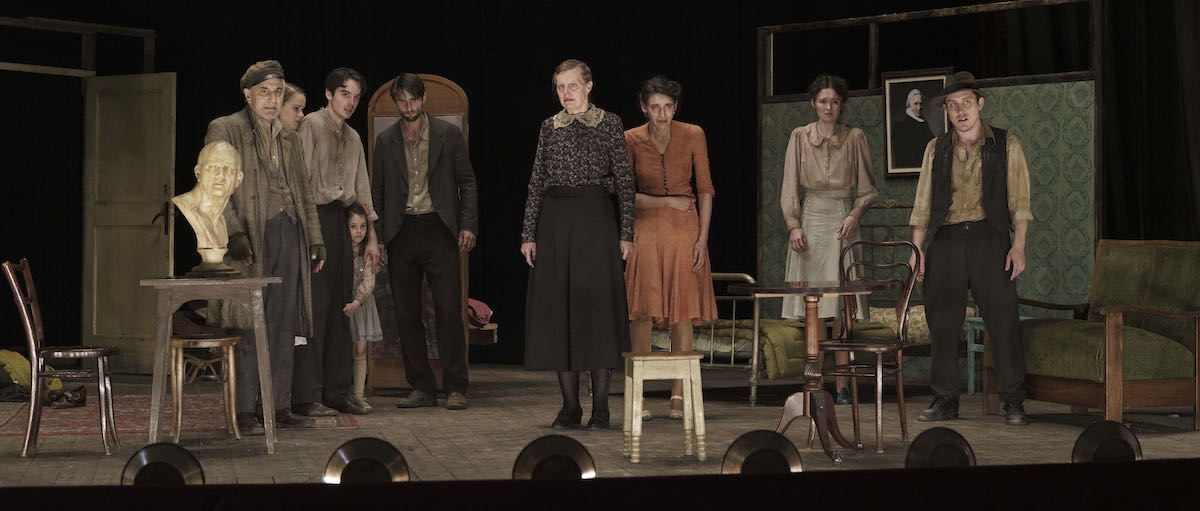
Love Gets a Room is an award-caliber new film featuring reputable actors and state-of-the-art cinema technology.
Set in Warsaw 1942, it takes its title from an actual play which was performed one time only as Nazi troops occupied Poland. In this film, a troupe of Jewish actors simultaneously stages the play while plotting escape from their besieged ghetto. The "room" of the title is analogous to Anne Frank's attic, a shelter for Jewish fugitives.
Love Gets a Room recreates that single performance in real time while imagining circumstances behind it. We follow Stefcia, the lead actor, who is desired by two other actors in the production. Stefcia loves Jozek, who has a rival in Patrik, who loves Stefcia and has stolen money to spirit her to safety. Only two people can get away undetected. With which suitor will Stefcia go? Schemes are hatched, choices are made, trusts are betrayed. A cast member observes, "What matters here is being loved, not loving."
The camera follows Stefcia in CGI-edited tracking shots, simulated long takes, as she glides, dips, and weaves through backstage walkways and intermittently pops into the action on the stage. The actors recite their lines, send codes in dialogue, exchange furtive glances, and frequently break into song. All goes well—the raucous full-house of working-class Jewish denizens is entertained—until the doors burst open, and armed Nazi soldiers walk in.
Love Gets a Room is written and directed by rising Spanish director Rodrigo Cortés. His previous films include Red Lights (2012) and Buried (2012). His next film boasts Martin Scorsese as executive producer. Love Gets a Room is a prestige production and will certainly vie for international awards.
That said.
I couldn't wait for it to be over.
It runs only a brisk 103 minutes, but the conceit of the film becomes concerning, then galling. Don't get me wrong: The actors are good. The plot generates pathos. The action is skillfully choreographed. Love Gets a Room recalls other movies and will be entertaining for many in a familiar way. But it treats frivolously a serious subject.
Some of the films it recalls are Schindler's List (1993) and Life is Beautiful (1997), both about the Jewish experience in WWII. It also recalls Birdman (2014) and 1917 (2019). Like those films, Love digitally simulates "real time" vicarious participation. It's a thrill ride. About the Holocaust.
Holocaust movies have always troubled. While the events are in the past, we are not far removed from them. Schindler's List took criticism when released and, despite its status as a classic, is still considered by some to be an appropriation, or exploitation of a tragic period of history.
Love Gets a Room is not history. It is Content, designed to be experienced as part of the current avalanche of digital product, like games and virtual reality. Its purpose is to make us feel as if we are there. It simulates actual experience.
Film is a passive medium for everybody but the filmmakers. It presents as visual art but does not engage the receiver's imagination in the same way as, say, literature. Nothing is required of viewers but our attention. We are voyeurs who tacitly witness struggles and sacrifices that for some will always represent catastrophic tragedy.
Rodrigo Cortés is a high-concept filmmaker, and this is his highest yet. To achieve his goal, Mr. Cortés' storytelling is reductive. There's nothing subtle about his symbolism, and it's all symbolism. The mise en scene is based on facile contrast: dark backstage against bright footlights, real vs. scripted, good vs. evil, black vs. white.
The theater experience is updated and contemporized. It asks us to believe that in 1942 beleaguered Jews, if they attended theater at all, would react with the same cadence as modern audiences. The auditorium itself is incongruously au courant, an immaculate palace that houses a colorful set on one end and a darkly attired audience on the other. Those ghetto dwellers en masse are caricatures. The caricatures comprise stagehands and members of the orchestra as well. When individual musicians are singled out, dressed as they are in rags, the effect is comical, like watching the Muppet Show.
Most of all, Love Gets a Room has a peculiar buoyancy. It's very pleased with itself in its planning. It moves with sustained jauntiness, rarely pausing to absorb the soberness of its premise.
Consider its points of view. We primarily trail Stefcia and see events unfold as she does. Sometimes she interacts with the other actors onstage. For a dramatic scene, our point of view changes, and we are with a Nazi officer in the front row, a character who briefly bridges stage and audience.
But notice. We never sit in the audience. We never sit amongst the tradespeople, the merchants, the urchins, the poor. Why is that? Is it too much of a downer to sit amongst the doomed? We never see them as individuals or other than a dark faceless mass. And we certainly don't follow them beyond the events of the film, after the final curtain, onto the trucks and trains. But we know history. We know their fate.
But there's no time to consider history or be indignant. Love Gets a Room must keep moving, bouncing along. We must keep that beachball aloft.
(Postscript: I wish much luck to the actors Clara Rugaard as Stefcia, Jack Roth as Jozek, Mark Ryder as Patryk, and Anastasia Hille as Irena. All of them are excellent, capable of nuance, and deserve long careers.)
_______________________________________________________
Love Gets a Room. Written and directed by Rodrigo Cortés, with excerpts from the play written by Jerzy Jurandot. 2021. A Nostromo Pictures production. 103 minutes. In theaters.
